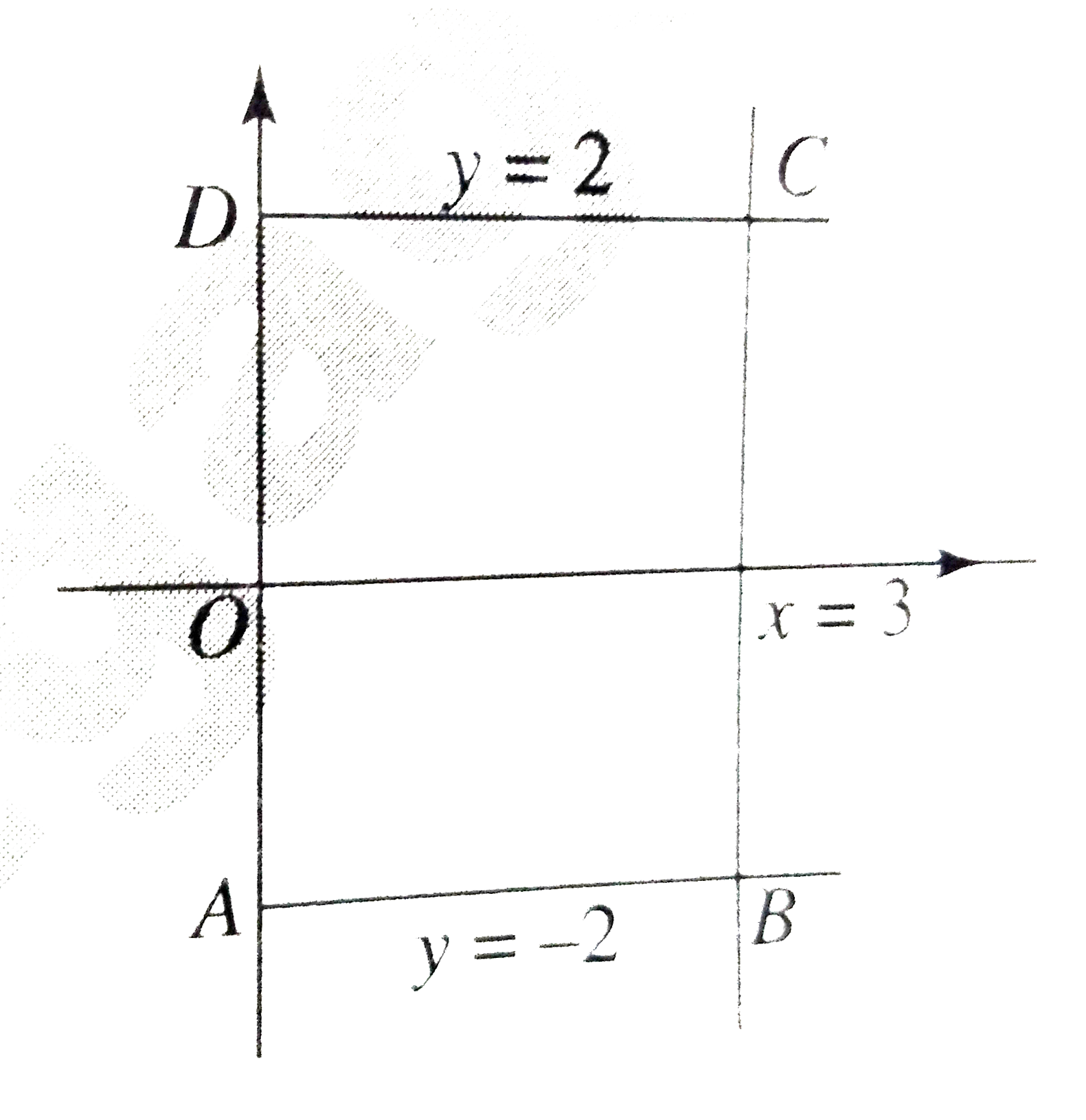Consider the region R in the Argand plane described by the complex number. Z satisfying the inequalities |Z−2|≤|Z−4|, |Z−3|≤|Z+3|, |Z−i|≤|Z−3i|, |Z+i|≤|Z+3i|
Answer the followin questions :
Maximum of |Z1−Z2| given that Z1, Z2 are any two complex numbers lying in the region R isSolution in Bengali
5
3
1
√13
The correct Answer is:D
(d) |Z−2|≤|Z−4|⇒|Z−2|2≤|Z−4|2
⇒(x−2)2+y2≤(x−4)2+y2
⇒8x−4x≤16−4
⇒x≤3
|Z−3|≤|Z+3|⇒x≥0
|Z−i|≤|Z−3i|⇒y≤2
|Z+i|≤|Z+3i|⇒y≥−2
So, z lies on or inside rectangle formed by lines x=0, x=3, y=−2 and y=2.
(1) Max of |Z|=OC or OB=√32+22=√13

Topper's Solved these Questions
- COMPLEX NUMBERSBOOK - CENGAGE PUBLICATIONCHAPTER - COMPLEX NUMBERSEXERCISE - ILLUSTRATION
110 Videos
- COMPLEX NUMBERSBOOK - CENGAGE PUBLICATIONCHAPTER - COMPLEX NUMBERSEXERCISE - SLOVED EXAMPLES
15 Videos
- COMPLEX NUMBERSBOOK - CENGAGE PUBLICATIONCHAPTER - COMPLEX NUMBERSEXERCISE - Matching Column
1 Videos
- CIRCLESBOOK - CENGAGE PUBLICATIONCHAPTER - CIRCLESEXERCISE - Comprehension Type
8 Videos
- CONIC SECTIONSBOOK - CENGAGE PUBLICATIONCHAPTER - CONIC SECTIONSEXERCISE - All Questions
102 Videos
Similar Questions
Evaluate :
(i) i135
(ii) i−47
(iii) (−√−1)4n+3,n∈N
(iv) √−25+3√−4+2√−9
View Solutionifωandω2 are the nonreal cube roots of unity and [1/(a+ω)]+[1/(b+ω)]+[1/(c+ω)]=2ω2 and [1/(a+ω)2]+[1/(b+ω)2]+[1/(c+ω)2]=2ω , then find the value of [1/(a+1)]+[1/(b+1)]+[1/(c+1)].
View SolutionEvaluate :
i−47
View Solution
In the diagram as shown, a circle is drawn with centre C(1,1) and radius 1 and a line L. The line L is tangent to the circle at Q. Further L meets the y-axis at R and the x-axis at P in such a way that the angle OPQ equals θ where 0<θ<π2.
Coordinate of Q is
View SolutionGiven that A(1,1) and B(2,−3) are two points and D is a point on AB produced such that AD=3AB. Find the coordinates of D.
View SolutionLet z_(1)=6+i&z_(2)=4-3i Let z be a a complex number such that arg((z-z_(1))/(z-z_(2)))=(pi)/(2) then z satisfies
View SolutionIf z1,z2,z3,z4 are complex numbers in an Argand plane satisfying z1+z3=z2+z4. A compex number 'z' lies on the line joining z1 and z4 such that Arg(z−z2z1−z2)=Arg(z3−z2z−z2). It is given that |z−z4|=5,|z−z2|=|z−z3|=6 then
View SolutionConsider the region R in the Argand plane described by the complex number. Z satisfying the inequalities |Z−2|≤|Z−4|, |Z−3|≤|Z+3|, |Z−i|≤|Z−3i|, |Z+i|≤|Z+3i|
Answer the followin questions :
The maximum value of |Z| for any Z in R is
View SolutionConsider the region R in the Argand plane described by the complex number. Z satisfying the inequalities |Z−2|≤|Z−4|, |Z−3|≤|Z+3|, |Z−i|≤|Z−3i|, |Z+i|≤|Z+3i|
Answer the followin questions :
Minimum of |Z1−Z2| given that Z1, Z2 are any two complex numbers lying in the region R is
View SolutionLet z and ω be two complex numbers such that |z|≤1,|ω|≤1 and |z+iω|=|z1−z2| is equal to
View SolutionComplex numbers z satisfy the equaiton |z−(4/z)|=2
Locus of z if |z−z1|=|z−z2|, where z1 and z2 are complex numbers with the greatest and the least moduli, is
View SolutionIf z1 and z2 are lying on |z−3|≤4 and |z−1|=|z+1|=3 respecively. Then d=|z1−z2| satisfies.
View SolutionLet z1,z2 be two fixed complex numbers in the Argand plane and z be an arbitrary point satisfying |z−z1|+|z−z2|=2|z1−z2| . Then the locus of z will be
View SolutionLet Z1,Z2 be two complex numbers which satisfy |z−i|=2 and ∣∣∣z−λiz+λi∣∣∣=1 where λ∈R, then |z1−z2| is
View SolutionIf z1=2−3iandz2=−1+i, then the locus of a point P represented by z=x+iy in the argand plane satisfying the equation arg (z−z1z−z2)=π2 is
View Solutionz1,z2 are two complex numbers with |z1−z2|< k. If the complex number z satisfies the condition |z1−z2|+|z−z2|= k , then z lies on
View Solution
